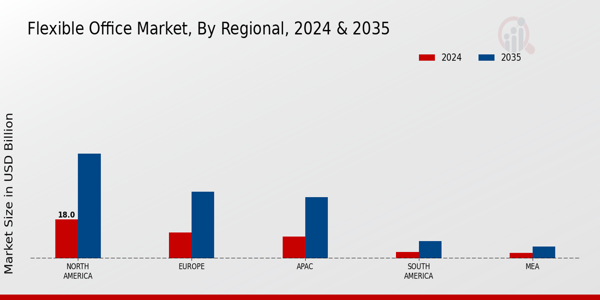Diverse Workforce Needs
The Global Flexible Office Market Industry is responding to the diverse needs of the modern workforce. As organizations become more inclusive and diverse, flexible office solutions cater to various employee preferences and work styles. This adaptability is crucial in attracting and retaining talent, as employees increasingly seek work environments that align with their personal and professional needs. Flexible office spaces can accommodate different work arrangements, from collaborative areas to quiet zones, thereby enhancing employee satisfaction and productivity. This responsiveness to workforce diversity is expected to bolster the market's growth, as companies recognize the value of creating inclusive work environments.
Market Growth Projections
The Global Flexible Office Market Industry is poised for substantial growth, with projections indicating a market size of 45.5 USD Billion in 2024 and an anticipated expansion to 120 USD Billion by 2035. This growth trajectory suggests a compound annual growth rate of 9.21% from 2025 to 2035, reflecting the increasing adoption of flexible workspaces across various sectors. The market dynamics are influenced by factors such as changing workforce demographics, technological advancements, and evolving corporate strategies. As businesses continue to embrace flexibility in their operations, the Global Flexible Office Market is likely to evolve, presenting new opportunities and challenges for stakeholders.
Technological Advancements
Technological innovations play a pivotal role in shaping the Global Flexible Office Market Industry. The integration of advanced communication tools, cloud computing, and smart office technologies facilitates seamless collaboration and enhances productivity in flexible workspaces. For instance, the implementation of IoT devices allows for real-time monitoring of office resources, optimizing space utilization and reducing operational costs. As businesses increasingly adopt these technologies, the demand for flexible office solutions is likely to rise, contributing to the market's projected growth. By 2035, the market is expected to expand to 120 USD Billion, underscoring the importance of technology in driving this transformation.
Corporate Real Estate Strategy Shift
A significant shift in corporate real estate strategies is influencing the Global Flexible Office Market Industry. Companies are moving away from traditional long-term leases towards more flexible arrangements that align with their evolving operational needs. This transition is driven by the desire to reduce overhead costs and enhance workforce mobility. As a result, flexible office spaces are becoming an integral part of corporate real estate portfolios. This shift not only allows businesses to respond swiftly to market changes but also fosters a culture of innovation and collaboration. The anticipated compound annual growth rate of 9.21% from 2025 to 2035 further highlights the impact of this strategic evolution.
Rising Demand for Flexible Workspaces
The Global Flexible Office Market Industry is experiencing a notable surge in demand for flexible workspaces, driven by the evolving preferences of businesses and employees alike. As organizations increasingly prioritize agility and adaptability, flexible office solutions provide the necessary infrastructure to support remote and hybrid work models. In 2024, the market is projected to reach 45.5 USD Billion, reflecting a growing recognition of the benefits associated with flexible work environments. This trend indicates a shift in corporate real estate strategies, where companies are opting for short-term leases and co-working spaces to enhance operational efficiency and employee satisfaction.
Sustainability and Environmental Concerns
Sustainability is increasingly becoming a focal point within the Global Flexible Office Market Industry. As organizations strive to meet environmental goals, flexible office solutions offer opportunities for energy-efficient designs and sustainable practices. Many flexible office providers are adopting green building certifications and implementing eco-friendly initiatives, such as waste reduction and energy conservation measures. This commitment to sustainability not only attracts environmentally conscious businesses but also enhances the overall appeal of flexible workspaces. The growing emphasis on corporate social responsibility is likely to drive further demand for sustainable flexible office solutions, contributing to the market's robust growth trajectory.
























Leave a Comment